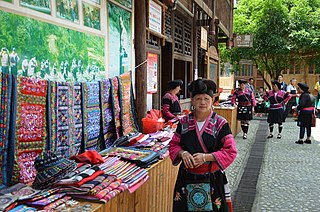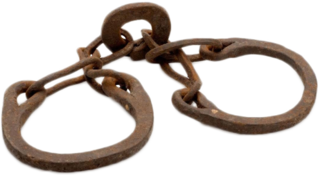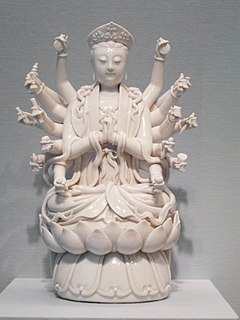 W
WThe lives of women in China have changed significantly due to the late Qing Dynasty reforms, the changes of the Republican period, the Chinese Civil War, and the rise of the People's Republic of China.
 W
WThe Biographies of Exemplary Women is a book compiled by the Han dynasty scholar Liu Xiang c. 18 BCE. It includes 125 biographical accounts of exemplary women in ancient China, taken from early Chinese histories including Chunqiu, Zuozhuan, and the Records of the Grand Historian. The book served as a standard Confucianist textbook for the moral education of women in traditional China for two millennia.
 W
WThe China Women’s Film Festival was established in 2013 as an annual event. It aspires to promote women’s rights and raise awareness of gender inequality through the mediums of film and art. The festival is organised by the Crossroads Centre Beijing, a Chinese NGO that aims to raise awareness on human rights issues in China.
 W
WIn Chinese contemporary popular culture, there are various aspects to the female beauty ideal.
 W
WComfort women or comfort girls were women and girls forced into sexual slavery by the Imperial Japanese Army in occupied countries and territories before and during World War II. The name "comfort women" is a translation of the Japanese ianfu (慰安婦), a euphemism for "prostitutes".
 W
WThe Four Books for Women was a collection of material intended for use in the education of young Chinese women. In the late Ming and Qing dynasties, it was a standard text read by the daughters of aristocratic families. The four books had circulated separately and were combined by the publishing house Duowen Tang in 1624.
 W
WIn 2014, China ranked 37th out of 187 countries on the United Nations Development Programme's Gender Inequality Index (GII). Among the GII components, China's maternal mortality ratio was 32 out of 100,000 live births. In education 58.7 percent of women age 25 and older had completed secondary education, while the counterpart statistic for men was 71.9 percent. Women's labour power participation rate was 63.9 percent, and women held 23.6 percent of seats in the National People's Congress.
 W
WThe study of the impact of globalization on women in China examines the role and status of Chinese women relative to the political and cultural changes that have taken place in the 20th century as a consequence of globalization. Globalization refers to the interaction and integration of people, products, cultures and governments between various nations around the globe; this is fostered by trade, investment, and information technology. Globalization affected women's rights and the gender hierarchy in China, in aspects of domestic life such as marriage and primogeniture, as well as in the workplace. These changes altered the quality of life and the availability of opportunities to women at different junctures throughout the modern globalization process.
 W
W"Iron Girls" is a term that was popularized in China during the 1950s through the 1970s. It was used to define a new idealized emerging group of working women who were strong and capable of performing highly demanding labor tasks, usually assigned to men. These tasks included repairing high-voltage electric wires, working at farmland, or heavy physical work. Iron Girls were a symbol of shifting gender norms during the Chinese Cultural Revolution of the 1960s and 1970s, and in the years following the cultural revolution they faced harsh criticism. Iron Girls relied on the false idea that men and women were inherently equal, but this idea was criticized by feminists for its emphasis on the division of labor. Accounts of Iron Girls are limited aside from state propaganda which was circulated during the Cultural Revolution. Propaganda images emphasized women with strong physical attributes as well as their ability to perform in jobs which had been dominated by men in the earlier years prior to the Cultural Revolution. Firsthand narratives in the form of memoirs which focus on other social issues at the time are some of the only pieces of evidence of the era available to historians, making it difficult to understand the reality of life as an Iron Girl.
 W
WNüshu is a syllabic script derived from Chinese characters that was used exclusively among women in Jiangyong County in Hunan province of southern China. Nüshu has been included in the Unicode Standard since June 2017.
 W
WOei Hui-lan, known as Madame Wellington Koo, was a Chinese-Indonesian international socialite and style icon, and, from late 1926 until 1927, the First Lady of the Republic of China. She was married firstly to British consular agent Beauchamp Caulfield-Stoker, then to the pre-communist Chinese statesman Wellington Koo, and was a daughter and heiress of the colonial Indonesian tycoon Oei Tiong Ham, Majoor der Chinezen.
 W
WThe Red Lanterns were the women's fighting groups organized by village women who were not allowed to join the men's groups during the Boxer Uprising of 1900. Villagers said these women had supernatural powers and were called upon to perform tasks which the male Boxers could not.
 W
WSexual slavery in China is sexual exploitation and slavery that occurs in the People's Republic of China.
 W
WSoong Mei-ling or, legally, Soong May-ling, also known as Madame Chiang Kai-shek or Madame Chiang, was a Chinese political figure who was First Lady of the Republic of China, the wife of Generalissimo and President Chiang Kai-shek. Soong played a prominent role in the politics of the Republic of China and was the sister-in-law of Sun Yat-sen, the founder and the leader of the Republic of China. She was active in the civic life of her country and held many honorary and active positions, including chairwoman of Fu Jen Catholic University. During the Second Sino-Japanese War, she rallied her people against the Japanese invasion; and in 1943 conducted an eight-month speaking tour of the United States of America to gain support. Her life traversed three centuries.
 W
WWidow chastity was an ideal in traditional Chinese cultural practices and beliefs that honored widowed women and discouraged their remarriage, encouraging them instead to live a life of "virtuous chastity". The idea of widow chastity has a long history in China, but the emphasis on the practice is believed to have its origin among Song dynasty Neo-Confucians, and reached a culmination and eventual end in the Qing era.
 W
WWomen in agriculture in China make up a diverse group of women who support agricultural activities in their country. Because China is a large country, rural women should not be considered a monolithic group, but instead have different strategies for success based on group or family relationships.
 W
WThe roles of women in Taoism have differed from the traditional patriarchy over women in ancient and imperial China. Chinese women had special importance in some Taoist schools that recognized their transcendental abilities to communicate with deities, who frequently granted women with revealed texts and scriptures. Women first came to prominence in the Highest Clarity School, which was founded in the 4th century by a woman, Wei Huacun. The Tang dynasty (618-907) was a highpoint for the importance of Daoist women, when one-third of the Shangqing clergy were women, including many aristocratic Daoist nuns. The number of Daoist women decreased until the 12th century when the Complete Perfection School, which ordained Sun Bu'er as the only woman among its original disciples, put women in positions of power. In the 18th and 19th centuries, women Daoists practiced and discussed nüdan, involving gender-specific practices of breath meditation and visualization. Furthermore, Daoist divinities and cults have long traditions in China, for example, the Queen Mother of the West, the patron of xian immortality, He Xiangu, one of the Eight Immortals, and Mazu, the protectress of sailors and fishermen.